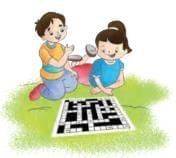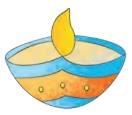Profit & Loss Chapter Notes | Mathematics Class 6 (Maharashtra Board) PDF Download
| Table of contents |

|
| Introduction |

|
| Examples of Profit and Loss |

|
| To Calculate Selling Price or Cost Price |

|
| Calculating Profit or Loss Percentage |

|
Introduction
A shopkeeper bought a mobile phone  for ₹ 28000 and sold it to you for ₹ 31000. Did he make a profit or a loss?
for ₹ 28000 and sold it to you for ₹ 31000. Did he make a profit or a loss?
To determine this, let's understand the basic concepts of Cost Price (C.P.) and Selling Price (S.P.)
Cost Price (C.P.). The price at which an item is purchased.
Selling Price (S.P.). The price at which an item is sold.
Now, coming back to the question, we see that:
- C.P. = ₹ 28000 (the price the shopkeeper paid)
- S.P. = ₹ 31000 (the price the shopkeeper sold it for)
Since ₹ 31000 (S.P.) > ₹ 28000 (C.P.), the shopkeeper made a profit.
How much was the profit?
Profit = Selling Price - Cost Price
= ₹ 31000 - ₹ 28000
= ₹ 3000
Therefore, the profit is ₹ 3000 .
Examples of Profit and Loss
Example 1: A shopkeeper bought a mobile phone for ₹ 28,000 and sold it for ₹ 31,000.How much money did he earn as profit?
Ans: Cost Price (C.P.) = ₹ 28,000 Selling Price (S.P.) = ₹ 31,000
Since S.P. > C.P., the shopkeeper made a profit.
Profit = S.P. - C.P.
Profit = ₹ 31,000 - ₹ 28,000 = ₹ 3,000
Example 2: Ms. Shalini bought a bedsheet for ₹ 1,600 and sold it for ₹ 1,350.How much money did she lose?

Ans: Cost Price (C.P.) = ₹ 1,600 Selling Price (S.P.) = ₹ 1,350
Since S.P. < C.P., Ms. Shalini incurred a loss.
Loss = C.P. - S.P.
Loss = ₹ 1,600 - ₹ 1,350 = ₹ 250
Key Points to Remember
- When S.P. > C.P., there is a profit. Profit = S.P. - C.P.
- When S.P. < C.P., there is a loss. Loss = C.P. - S.P.
Example 3: A board game is bought for ₹853.25 and sold for ₹825.50. Find the profit or loss made.

Ans: To determine if there is a profit or loss, we compare the Cost Price (C.P.) and Selling Price (S.P.).
In this case, since C.P. ( ₹ 853.25 ) > S.P. ( ₹ 825.50 ), it indicates a loss.
To calculate the loss: Loss = C.P. - S.P.
Loss = ₹853.25 - ₹825.50 = ₹27.75
Example 4: A dealer bought 20 TV sets for ₹31500 each, paid ₹3600 as the cartage for all and sold these at ₹35000 each. Find his total profit or loss.
Ans: The dealer sold each TV set for ₹35,000, resulting in a total selling price of ₹700,000 for all 20 sets.
Since the selling price ( ₹700,000 ) is greater than the cost price ( ₹633,600 ), the dealer made a profit.
To calculate the profit: Profit = Selling Price - Cost Price Profit = ₹700,000 - ₹633,600 = ₹66,400
Therefore, the dealer made a profit of ₹66,400 on the sale of the TV sets.
Note on Overheads
- Overheads such as repair costs, transportation charges, octroi, etc., are considered part of the cost price.
- These additional costs are added to the cost price when calculating the total cost of an item.
To Calculate Selling Price or Cost Price
(i) To Determine Selling Price
Formula 1. When Cost Price and Profit are Given: Selling Price = Cost Price + Profit
Formula 2. When Cost Price and Loss are Given: Selling Price = Cost Price - Loss
Example 5: The cost price of a chair  is ₹3120 and is sold by making a profit of ₹580. What is the selling price of the chair?
is ₹3120 and is sold by making a profit of ₹580. What is the selling price of the chair?
Ans: Cost Price = ₹ 3120, Profit = ₹ 580
Selling Price = Cost Price + Profit
= ₹ 3120 + ₹ 580 = ₹ 3700
Example 6: A book  is bought for ₹97.50 and sold by incurring a loss of ₹12.35. Find the selling price of the book.
is bought for ₹97.50 and sold by incurring a loss of ₹12.35. Find the selling price of the book.
Ans: Cost Price = ₹ 97.50, Loss = ₹ 12.35
Selling Price = Cost Price - Loss
= ₹ 97.50 - ₹ 12.35 = ₹ 85.15
(ii) To Determine Cost Price
Formula 1. When Selling Price and Profit are Given: Cost Price = Selling Price - Profit
Formula 2. When Selling Price and Loss are Given: Cost Price = Selling Price + Loss
Example 7: Bicycle is sold for ₹ 2140 with a profit of ₹ 153. What is the cost price of the bicycle?
Ans: Selling Price = ₹ 2140, Profit = ₹ 153
Cost Price = Selling Price - Profit
= ₹ 2140 - ₹ 153 = ₹ 1987
Example 8: Find the cost price of a pair of slippers sold at ₹ 345 with a loss of ₹ 25.
Ans: Selling Price = ₹ 345, Loss = ₹ 25
Cost Price = Selling Price + Loss
= ₹ 345 + ₹ 25 = ₹ 370
Calculating Profit or Loss Percentage
Example 9. A man buys decorated diyas  at ₹10 each and sells them at ₹12.50 each. Find his profit per cent on each diya.
at ₹10 each and sells them at ₹12.50 each. Find his profit per cent on each diya.
Ans: Cost Price (C.P.) of each diya = ₹ 10
Selling Price (S.P.) of each diya = ₹ 12.50
Profit = S.P. - C.P. = ₹ 12.50 - ₹ 10 = ₹ 2.50
Profit Percentage. (Profit / C.P.) × 100 = (₹ 2.50 / ₹ 10) × 100% = 25%
Therefore, the man makes a profit of 25% on selling each diya.
|
30 videos|112 docs|15 tests
|
FAQs on Profit & Loss Chapter Notes - Mathematics Class 6 (Maharashtra Board)
| 1. What is the basic definition of profit and loss in a business context? |  |
| 2. How do you calculate the selling price of an item if you know the cost price and the profit? |  |
| 3. What is the formula for calculating profit percentage? |  |
| 4. Can you explain how to determine the loss percentage? |  |
| 5. What examples illustrate the concepts of profit and loss in real life? |  |



















